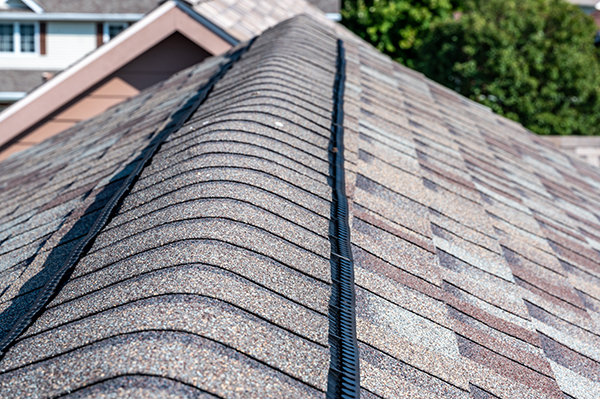What Is a Ridge Vent?
Author: Dan Stout | November 6, 2023
Every roof needs to have proper air circulation, no matter if it's designed to be vented or nonvented. One of the oldest and most dependable ways to vent a roof is with a ridge vent. Let's take a look at what a ridge vent is, why they're so popular and whether or not your roof needs one.

What Is a Ridge Vent?
A ridge vent is an opening at the peak of a sloped roof. A ridge vent removes the top few inches of the peak and replaces it with a raised covering, or ridge cap. Air enters through separate vents, circulates and exits through the ridge vent, taking excess heat and moisture along with it. Ridge vents use baffles, or breathable membranes, to keep the attic closed off from rain and prevent animal intrusion.
Ridge vents are unique to pitched roofs. Flat roofs don't have ridges and require other ventilation methods.
What Are the Benefits of a Ridge Vent?
During the warmer months, ridge vents allow heat to escape and remove excess moisture that could lead to mildew and rot. In winter, they keep the attic cold, helping to prevent ice dams. Proper ventilation helps you save on energy bills, reduces the chance of leaks and discourages mold growth.
Ridge vents can also extend the life of the roof. Roofs are relatively thin; if one side is allowed to change temperature more rapidly than the other, the roofing and sheathing will swell and shrink. This loosens fasteners such as nails and caulking, creating potential leak points. Proper venting allows the roof to heat up and cool down as one unit, extending its life span and reducing the chance of leaks.
Ridge vents are also popular with homeowners because they're less noticeable from the street than box vents. This gives the roof a sleeker appearance and enhances curb appeal.
What Is a Ridge Vent Installation Like?
Installation of a ridge vent is relatively straightforward, whether on a new build or as a retrofit. A contractor will use a saw to remove the tip of the roof's peak, lay down a preassembled ridge vent, nail and caulk it into place and top it with a material that matches the existing roof. (They can also use a ridge vent with a standalone finish.)
While this is an easy task for a professional roofer, it requires expert skill and safety preparedness. Since most people are not comfortable working at steep heights or sawing open a roof, it's best left to the pros.
Do I Need a Ridge Vent?
Ventilation is like any other element of structural science: The trick is to find the proper amount. You only need a ridge vent if your attic is under-ventilated.
Homes are unique; a home built in the 1940s in coastal Georgia has a different environment and material than one built in the early 2000s in Arizona. So, while it's hard to analyze your ventilation needs without the help of a contractor who knows what variables to consider, a good rule of thumb is to take the temperature in your attic two to three hours after sundown. At that point, an un-air-conditioned attic's temperature should be within 10 to 15 degrees Fahrenheit of the temperature outdoors. If it's dramatically different, it's time to consider taking action.
The Department of Energy also suggests looking for signs of excess moisture such as warped wood or wet insulation. If you spot water damage inside your home, it may be time to call a roofing contractor.